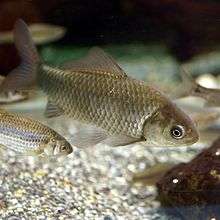Ginbuna
The ginbuna (Carassius langsdorfii), sometimes referred to as silver crucian carp or Japanese silver crucian carp, is a species of freshwater fish in the carp family (family Cyprinidae).[1][2] It is native to lakes and rivers in Japan.[3]
| Ginbuna | |
|---|---|
 | |
| Scientific classification | |
| Kingdom: | Animalia |
| Phylum: | Chordata |
| Class: | Actinopterygii |
| Order: | Cypriniformes |
| Family: | Cyprinidae |
| Subfamily: | Cyprininae |
| Genus: | Carassius |
| Species: | C. langsdorfii |
| Binomial name | |
| Carassius langsdorfii | |
| Synonyms | |
| |
Description
Ginbuna is a deep- and thick-bodied fish with a terminal mouth and a large caudal fin. It possesses 5 anal fin rays, 41–57 gill rakers, and has 28–31 large lateral line scales.[1] It reaches a maximum length of 39 centimetres (15 in).[2]
This species is parasitized by myxozoan cnidarians of the genus Myxobolus, which infest their gills.[4]
Taxonomy
The ginbuna can be difficult to distinguish from the common goldfish (Carassius auratus), to which it is closely related.[1] In fact, it has often been treated as a subspecies of goldfish. However, current genetic data suggests that the ginbuna is a distinct species.[5] The ginbuna commonly hybridizes with other species in its genus where they come into contact, as well as with the closely related common carp.[6]
It is believed that the ginbuna originated as a hybrid of two different species, although the parent species are unknown.[7]
Distribution and habitat
The ginbuna is native to Japan, where it is widespread,[5] but has been introduced to many other parts of the world. In Europe it has been confirmed in the Elbe River system in the Czech Republic, Greece, Germany, Ukraine, Italy, and the Neretva basin in Bosnia and Herzegovina.[8][9] Haplotype data indicates that European ginbuna derive from populations in either Honshu Island or the Ryukyu Islands, suggesting multiple introduction events.[9] Additionally, a 2018 study using mtDNA discovered the fish in Lake Tahoe, California and in a pond on the campus of the University of British Columbia, the first time this species has been found in North America.[6] These introductions may have been a result of ginbuna being unintentionally included with imports of goldfish or koi carp.[8]
It is a demersal species,[2] favoring confluences of tributaries and still downstream waters of rivers, as well as marshes.[10] Muddy substrates are preferred.[11]
Diet
Ginbuna are omnivorous. They eat benthic organisms, algae, zooplankton, and will opportunistically consume other items.[10]
Reproduction
Unusually among vertebrates, the ginbuna species has two different reproductive modes. The diploid form practices the usual sexual reproduction. However, the triploid and rare tetraploid forms practice a type of asexual reproduction known as gynogenesis, in which the sperm contributes no genetic material, but its presence is required for egg development.[3][12]
Importance to humans
The clonal nature of polyploid ginbuna makes them an ideal model fish for studying diseases of other cyprinid species.[13] This usefulness derives from the absence of genetic variance within the clone.[12]
References
- Daniel, W. M.; Morningstar, C. (2 July 2018). "Carassius langsdorfii Temminck & Schlegel, 1846". Nonindigenous Aquatic Species Database. Gainesville, FL: U.S. Geological Survey. Retrieved 21 November 2018.
- Froese, Rainer and Pauly, Daniel, eds. (2014). "Carassius langsdorfii" in FishBase. February 2014 version.
- Murakami, Masaru; Matsuba, Chikako; Fujitani, Hideo (2001). "The maternal origins of the triploid ginbuna (Carassius auratus langsdorfi): Phylogenetic relationships within the C. auratus taxa by partial mitochondrial D-loop sequencing". Genes & Genetic Systems. 76: 25–32. doi:10.1266/ggs.76.25.
- Kato, Eigo; Kasai, Akihiro; Tomochi, Hisayuki; Li, Ying-Chun; Sato, Hiroshi (2017). "Four Myxobolus spp. (Myxosporea: Bivalvulida) from the gill lamellae of common carp (Cyprinus carpio) and Japanese silver crucian carp (Carassius langsdorfii) in the western part of Japan, with the description of three new species (M. tanakai n. sp., M. paratoyamai n. sp., and M. ginbuna n. sp.)". Parasitology Research. 116 (9): 2427–2441. doi:10.1007/s00436-017-5545-4. PMID 28681102.
- Kalous, Lukáš; Slechtova, V.; Bohlen, Jörg; Petrtýl, Miloslav; Svatora, M. (March 2007). "First European record of Carassius langsdorfii from the Elbe basin". Journal of Fish Biology. 70: 132–138. doi:10.1111/j.1095-8649.2006.01290.x.
- Halas, Dominik; Lovejoy, Nathan; Mandrak, Nicholas (2018). "Undetected diversity of goldfish (Carassius spp.) in North America". Aquatic Invasions. 13 (2): 211–219. doi:10.3391/ai.2018.13.2.03.
- Ohara, Kenichi; Ariyoshi, Takahiro; Sumida, Eiji; Taniguchi, Nobuhiko (2003). "Clonal diversity in the Japanese silver crucian carp, Carassius langsdorfii inferred from genetic markers". Zoological Science. 20 (6): 797–804. doi:10.2108/zsj.20.797. PMID 12832833.
- Kalous, L.; Rylkov, K.; Bohlen, J.; Sanda, R.; Petrtyl, M. (2013). "New mtDNA data reveal a wide distribution of the Japanese ginbuna Carassius langsdorfii in Europe". Journal of Fish Biology. 82 (2): 703–707. doi:10.1111/j.1095-8649.2012.03492.x. PMID 23398078.
- Rylková, Kateřina; Kalous, Lukáš; Bohlen, Jörg; Lamatsch, Dunja K.; Petrtýl, Miloslav (2013). "Phylogeny and biogeographic history of the cyprinid fish genus Carassius (Teleostei: Cyprinidae) with focus on natural and anthropogenic arrivals in Europe". Aquaculture. 380–383: 13–20. doi:10.1016/j.aquaculture.2012.11.027.
- Kajiwara, Yoko; Kashiwagi, Nobuhisa; Kadokami, Kiwao (2007). "Nationwide study of dioxins in the freshwater fish Carassius auratus ('gibelio) langsdorfii (crucian carp) in Japan: Concentrations and estimation of source contribution ratios". Chemosphere. 69 (8): 1177–1187. doi:10.1016/j.chemosphere.2007.06.034. PMID 17675214.
- Yamazaki, M.; Tanizaki, Y.; Shimokawa, T. (1996). "Silver and other trace elements in a freshwater fish, Carassius auratus langsdorfii, from the Asakawa River in Tokyo, Japan". Environmental Pollution. 94 (1): 83–90. doi:10.1016/s0269-7491(96)00053-x.
- Sakamoto, Kenji; Koedprang, Worawut; Nakajima, Masamichi; Taniguchi, Nobuhiko (2002). "Thermal resistance traits of the clonal silver crucian carp Carassius langsdorfii and evaluation of these traits using primary culture cells". Fisheries Science. 68 (5): 1029–1033. doi:10.1046/j.1444-2906.2002.00528.x.
- Nanjo, A.; Shibata, T.; Saito, M.; Yoshii, K.; Tanaka, M.; Nakanishi, T.; Fukuda, H.; Sakamoto, T.; Kato, G.; Sano, M. (2017). "Susceptibility of isogeneic ginbuna Carassius auratus langsdorfii Temminck et Schlegel to cyprinid herpesvirus‐2 (CyHV‐2) as a model species". Journal of Fish Diseases. 40 (2): 157–168. doi:10.1111/jfd.12500. PMID 27150547.